
eBook - ePub
Mathematics: The Man-Made Universe
Sherman K. Stein
This is a test
Partager le livre
- 592 pages
- English
- ePUB (adapté aux mobiles)
- Disponible sur iOS et Android
eBook - ePub
Mathematics: The Man-Made Universe
Sherman K. Stein
Détails du livre
Aperçu du livre
Table des matières
Citations
À propos de ce livre
Anyone can appreciate the beauty, depth, and vitality of mathematics with the help of this highly readable text, specially developed from a college course designed to appeal to students in a variety of fields. Readers with little mathematical background are exposed to a broad range of subjects chosen from number theory, topology, set theory, geometry, algebra, and analysis.
Starting with a survey of questions on weight, the text discusses the primes, the fundamental theorem of arithmetic, rationals and irrationals, tiling, tiling and electricity, probability, infinite sets, and many other topics. Each subject illustrates a significant idea and lends itself easily to experiments and problems. Useful appendices offer an overview of the basic ideas of arithmetic, the rudiments of algebra, suggestions on teaching mathematics, and much more, including answers and comments for selected exercises.
Starting with a survey of questions on weight, the text discusses the primes, the fundamental theorem of arithmetic, rationals and irrationals, tiling, tiling and electricity, probability, infinite sets, and many other topics. Each subject illustrates a significant idea and lends itself easily to experiments and problems. Useful appendices offer an overview of the basic ideas of arithmetic, the rudiments of algebra, suggestions on teaching mathematics, and much more, including answers and comments for selected exercises.
Foire aux questions
Comment puis-je résilier mon abonnement ?
Il vous suffit de vous rendre dans la section compte dans paramètres et de cliquer sur « Résilier l’abonnement ». C’est aussi simple que cela ! Une fois que vous aurez résilié votre abonnement, il restera actif pour le reste de la période pour laquelle vous avez payé. Découvrez-en plus ici.
Puis-je / comment puis-je télécharger des livres ?
Pour le moment, tous nos livres en format ePub adaptés aux mobiles peuvent être téléchargés via l’application. La plupart de nos PDF sont également disponibles en téléchargement et les autres seront téléchargeables très prochainement. Découvrez-en plus ici.
Quelle est la différence entre les formules tarifaires ?
Les deux abonnements vous donnent un accès complet à la bibliothèque et à toutes les fonctionnalités de Perlego. Les seules différences sont les tarifs ainsi que la période d’abonnement : avec l’abonnement annuel, vous économiserez environ 30 % par rapport à 12 mois d’abonnement mensuel.
Qu’est-ce que Perlego ?
Nous sommes un service d’abonnement à des ouvrages universitaires en ligne, où vous pouvez accéder à toute une bibliothèque pour un prix inférieur à celui d’un seul livre par mois. Avec plus d’un million de livres sur plus de 1 000 sujets, nous avons ce qu’il vous faut ! Découvrez-en plus ici.
Prenez-vous en charge la synthèse vocale ?
Recherchez le symbole Écouter sur votre prochain livre pour voir si vous pouvez l’écouter. L’outil Écouter lit le texte à haute voix pour vous, en surlignant le passage qui est en cours de lecture. Vous pouvez le mettre sur pause, l’accélérer ou le ralentir. Découvrez-en plus ici.
Est-ce que Mathematics: The Man-Made Universe est un PDF/ePUB en ligne ?
Oui, vous pouvez accéder à Mathematics: The Man-Made Universe par Sherman K. Stein en format PDF et/ou ePUB ainsi qu’à d’autres livres populaires dans Mathematics et Number Theory. Nous disposons de plus d’un million d’ouvrages à découvrir dans notre catalogue.
Informations
Sujet
MathematicsSous-sujet
Number Theory1
Questions on Weighing
This chapter will raise some important questions about numbers. While they may seem to be mere recreational puzzles that could be understood and investigated by anyone who can do simple arithmetic, in fact they concern a fundamental property in number theory. Not until Chapter 3 will the “why” behind the answers be considered. The goal of this chapter is to offer an opportunity to experiment with an open-ended problem and to see how a single mathematical idea can appear in a variety of disguises.
The questions, which concern weighing, will be introduced by a few examples. Say that we have a two-pan scale of the type seen in chemistry labs and statues of “Justice”:

Furthermore, we have an unlimited supply of 5- and 7-ounce measures. Now, supposing that potatoes weigh only whole numbers of ounces, rather than any amount as they actually do, let us ask which potatoes we would be able to weigh with our balance and our two types of measures.
For instance, using only the 5-ounce measures, we can weigh 5, 10, 15, 20, 25, 30, 35, . . . ounces. Or using only the 7-ounce measures, we can weigh 7, 14, 21, 28, 35, . . . ounces. Moreover, we could place one of each type together on a pan:
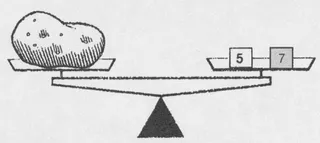
Thus we can weigh 12 ounces, 12 = 5 + 7. Or we could put one of each type of weight alone on a pan:
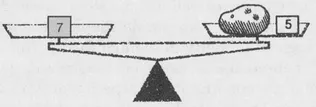
In this way we can weigh 2 ounces, since a potato of this weight, together with the 5-ounce measure, balances the 7-ounce measure.
Can we weigh a 3-ounce potato? Yes, by placing two 5-ounce measures on one pan and a 7-ounce measure with the potato:
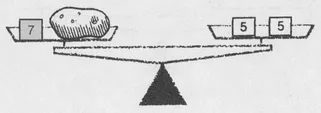
The balancing records the equation 3 + 7 = 2 ⋅ 5.
Can we weigh a 4-ounce potato? Yes. For instance, by placing two 5-ounce measures with the potato and two 7-ounce measures on the other pan:
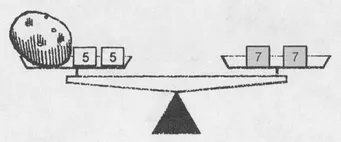
The corresponding equation is
4 + 2 ⋅ 5=2 ⋅ 7.
Or we could place three 7-ounce measures with the potato, which then balance five 5-ounce measures. The equation in this case is 4 + 3 ⋅ 7 = 5 ⋅ 5.
Can we weigh a 1-ounce potato? Even this can be done, as the reader may prefer to work out for himself before reading the next sentence. Two 7-ounce measures and the potato on one pan balance three 5-ounce measures on the other pan. The reader may wish to pause and devise still other ways of measuring this 1-ounce potato with 5- and 7-ounce measures.
Once we know that we can weigh a 1-ounce potato, then we know that we can weigh any number of ounces. For instance, we can weigh a 6-ounce potato as follows. First recall that two 7-ounce measures and a 1-ounce potato balance three 5-ounce measures:
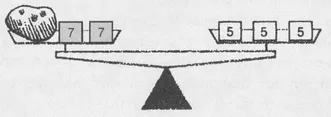
Repeating this arrangement of measures six-fold weighs a six-ounce potato. That is, from the relation 1 + 2 ⋅ 7 = 3 ⋅ 5 5 it follows that 6(1 + 2 ⋅ 7) = 6(3 ⋅ 5) or
6 + 12 ⋅ 7 = 18 ⋅ 5.

Of course, this may not be the simplest method for weighing a 6-ounce potato. Indeed, 6 + 3 ⋅ 5 5 = 3 ⋅ 7, so we could have managed by placing three 5-ounce measures with the potato and three 7-ounce measures on the other pan. But the reasoning at least assures us that if we can weigh a 1-ounce potato with a supply of two types of measures, then we can weigh any whole number of ounces with those measures.
So much for the combination 5 and 7. Suppose we turn to another combination, 8 and 21. Even if we have only 8-ounce and 21-ounce measures available, we can measure a 1-ounce potato, since
1 + 3 ⋅ 21 = 8 ⋅ 8.
Eight 8-ounce measures on one pan will balance the potato and three 21-ounce measures on the other pan.
The reader may now suspect that perhaps any pair of measures can weigh a 1-ounce potato. But this is not so. If, for example, we have only 6-ounce and 8-ounce measures, then we could never hope to measure a 1-ounce potato, or, for that matter, any odd number of ounces. (The reader should pause to think about why this is so.)
We are now in a position to ask some basic questions. Suppose we have at our disposal an unlimited supply of measures of two types. How can we decide whether we can weigh a 1-ounce potato with them? For instance, can we use 539-ounce and 1619-ounce measures to weigh a 1-ounce potato? More generally we can ask: What potatoes can we weigh with an unlimited supply of two given types of measures? Keep in mind that all potatoes and measures weigh a whole number of ounces (0, 1, 2, 3, 4, . . .). The whole numbers will usually be referred to as the natural numbers.
The questions really concern numbers, not potatoes. Let us gradually translate the second question into the language of numbers: Denote the weights of the two measures by A and B ounces respectively. In our first combination we had A = 5 and B = 7. The weight of the potato will be denoted by W ounces.
There are various methods of weighing the potato. One consists in putting several A-ounce measures on the pan with the potato and several B-ounce measures on the other pan. How many of each we use will depend on W, A, B, and our arithmetic. Say that we use X of the A-ounce measures and Y of the B-ounce measures:
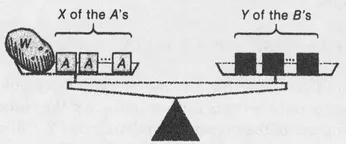
The corresponding equation is
W + XA = YB,
an equation that asserts merely that the scale in the figure balances. (We omit the multiplication sign between letters.)
For A = 5 and B = 7, let us see what X and Y are for various W. When W = 1, for instance, we have 1 + 4 ⋅ 5 = 3 ⋅ 7. Here X = 4 and Y = 3. Also 1 + 11 ⋅ 5 = 8 ⋅ 7, so that X = 11 and Y = 8 also perform the weighing when W=1.
Another method of weighing consists in placing only B-ounce measures with the potato and only A-ounce measures on the other pan. For A = 5, B = 7, the equation 1 + 2 ⋅ 7 = 3 ⋅ 5 illustrates this. We have W + XB = YA, where W = 1, X = 2, Y = 3.
A third method consists in placing the potato on one pan and the measuring weights on the other pan. For example, if W = 12 we have 12 = 5 + 7; if W = 27 we have 27 = 4 ⋅ 5 + 1 ⋅ 7. This method corresponds to an equation of the type W = XA + YB.
No other practical method exists, for there would be no point in placing measures of equal weight on both pans, since they could be removed without affecting the balance. Thus we need to consider only three types of equations:
W + XA = YB, W + XB = YA, W = XA + YB.
In all of these, X and Y are to be natural numbers, possibly including zero. The question about potatoes now becomes one about natural numbers: Let A and B be natural numbers. For which natural numbers W can we find natural numbers X and Y such that at least one of these equations holds:
W + XA = YB, W + XB = YA, W = XA + YB?
The potatoes are gone, but we are left with t...